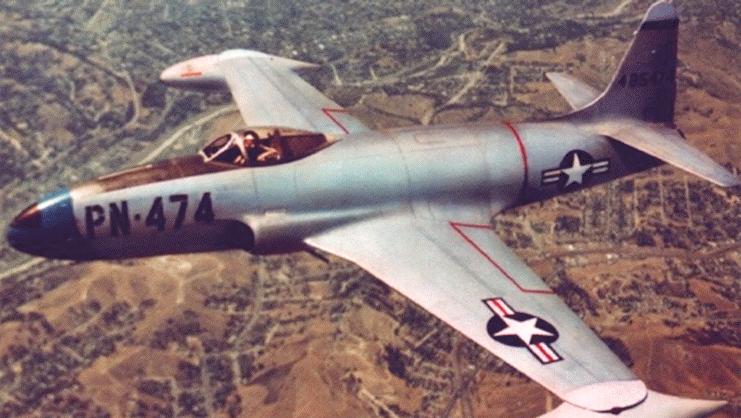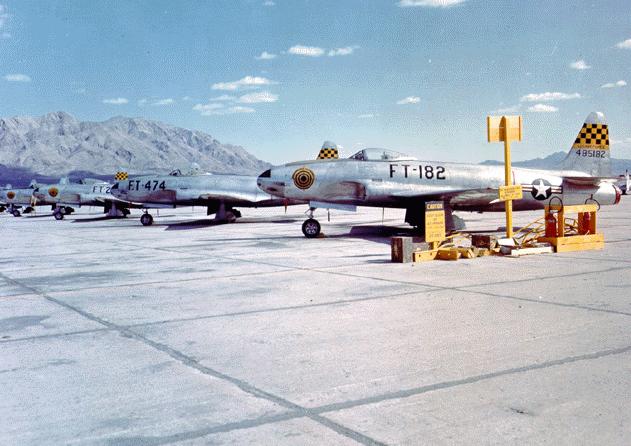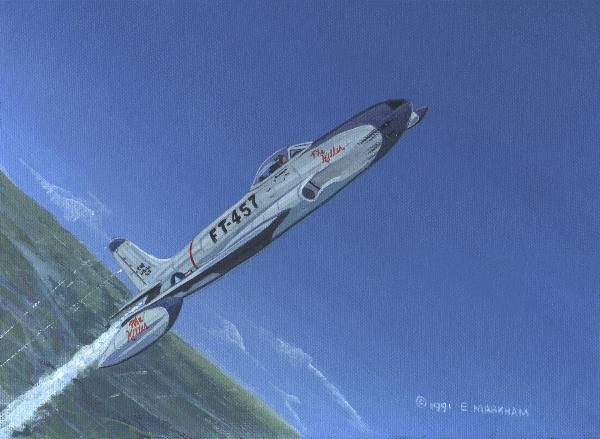Skip to comments.
The FReeper Foxhole Remembers Col. Freeman at The Siege at Chipyong-Ni (Feb, 1951) - Apr 7th, 2004
Army Magazine ^
| September 2002
| Lt. Col. Keith Alan Landry
Posted on 04/07/2004 12:00:08 AM PDT by SAMWolf
click here to read article
Navigation: use the links below to view more comments.
first previous 1-20, 21-40, 41-60, 61-80 ... 121-126 next last
To: All
|
Air Power
Lockheed P-80 "Shooting Star"
 |
Few airplanes in the history of aeronautics have been as successful as the Lockheed Shooting Star. It was the first operational jet fighter in the United States when it went into service in 1945. It emerged as victor in the world's first all-jet combat, and it won the distinction of remaining in production for a full 15 years after the experimental model was first flown.
The airplane had its origin in June 1943, when Lockheed was requested to design a fighter around the De Havilland turbojet engine developed in England in response to Germany's twin-engine jet fighter, the Messerschmitt Me 262. The XP-80 was designed and built in the amazing period of only 143 days--37 days less than the original schedule. It was flown for the first time on January 8, 1944, and its performance was considered sensational.
"It was a magnificent demonstration," said Clarence Johnson, Lockheed's chief research engineer. "our plane was a success -- such a complete success that it had overcome the temporary advantage the Germans had gained from years of preliminary development on jet planes."
The Army Air Force planned to build the Shooting Star in large numbers. However, only two of the machines arrived in Italy before the end of the war in Europe, and these were never used in operations. Despite the cessation of hostilities, production was continued on a reduced scale.
Lockheed built 917 F-80A's and B's, one of which was modified for an attempt on the world speed record. on June 19, 1947, this plane set a speed mark of 623.8 miles per hour. Some of these modifications were retained in the F-80C, 798 of which were produced in 1948 and 1949. At the same time, Lockheed designed a two-seat version, the F-94 Starfire. This model was equipped with radar for all-weather operations.
When war started in Korea, F-80's were sent to the battle area to help the South Koreans. On November 10, 1950, Lieutenant Russell Brown, flying a Shooting Star, made history when he destroyed a Russian MiG-15 fighter in the world's first decisive all-jet combat.
Final version of the plane was the T-33 trainer, which remained in continuous production until August 1959. The T-33A was a very hot fighter to handle, compared to slower piston engine aircraft, and an alarming number of airplanes were lost. The solution was a redesigned T-33A two seat trainer. Engineers at Lockheed called their operation the "Skunk Works", named after an imaginary factory in the "Li'l Abner" comic strip.
The Army Air Force planned to build the Shooting Star in large numbers. However, only two of the machines arrived in Italy before the end of the war in Europe, and these were never used in operations. Despite the cessation of hostilities, production was continued on a reduced scale.
Lockheed built 917 F-80A's and B's, one of which was modified for an attempt on the world speed record. on June 19, 1947, this plane set a speed mark of 623.8 miles per hour. Some of these modifications were retained in the F-80C, 798 of which were produced in 1948 and 1949. At the same time, Lockheed designed a two-seat version, the F-94 Starfire. This model was equipped with radar for all-weather operations.
When war started in Korea, F-80's were sent to the battle area to help the South Koreans. On November 10, 1950, Lieutenant Russell Brown, flying a Shooting Star, made history when he destroyed a Russian MiG-15 fighter in the world's first decisive all-jet combat.
Final version of the plane was the T-33 trainer, which remained in continuous production until August 1959. The T-33A was a very hot fighter to handle, compared to slower piston engine aircraft, and an alarming number of airplanes were lost. The solution was a redesigned T-33A two seat trainer. Engineers at Lockheed called their operation the "Skunk Works", named after an imaginary factory in the "Li'l Abner" comic strip.
Specifications:
Manufacturer: Lockheed
Primary role: Ground attack / fighter
Powerplant: One General Electric J33-GE-11 or Allison J33-A-9 with 3,850 lb S.T. (1,746 kg).
Crew: one
Dimensions:
Wing span: 38 ft 10 in (11.83 m)
Length: 34 ft 6 in (10.51 m)
Height: 11 ft 4 in (3.45 m)
Weights: Empty: 7,920 lb (3,593 kg) / Gross: 11,700 lb (5,307 kg) / Max. Take-Off: 14,000 lb (6,350 kg)
Fuel Capacity: Normal: 425 gal (1,609 lt) / Maximum: 885 gal (3,350 lt)
Performance :
Maximum Speed: 558 mph (898 km/h) @ Sea Level
Maximum Speed: 492 mph (792 km/h) @ 40,000 ft (12,192 km)
Cruise Speed: 410 mph (660 km/h)
Climb: 5.5 minutes to 20,000 ft (6,096 km) / 1 minute to 4,580 ft (1,396 m)
Service Ceiling: 45,000 ft (1,3716 m)
Range: 780 miles (1,255 m) / Maximum: 1,440 miles (2,317 m)
Armaments:
Six .50 machine guns;
2,000 lb (907 kg) bombs, or ten .5 inch rockets
Websites about this plane and the groups that used them:
8th & 15th Tac Recce Squadron"The Cottonpickers"
Air Force Magazine - Aircraft of the Korean war
80th Fighter Squadron - "The Headhunters"





All information and photos Copyright of their respective owners/websites
41
posted on
04/07/2004 10:03:27 AM PDT
by
Johnny Gage
(God Bless our Firefighters, our Police, our EMS responders, and our Veterans)
To: Valin
1930 Andrew Sachs actor (Manuel-Fawlty Towers) 
To: SAMWolf
The Korea Vets faced down tremendous odds and they did it without all the high tech gadgets we have today, pretty much with WWII technology.
You're right, those vets don't get the respect they deserve. Truman insisting that Korea was a "police action" was quite an insult IMHO. When was the last time the NYPD or LAPD took on five infantry divisions??
43
posted on
04/07/2004 10:09:01 AM PDT
by
colorado tanker
("There are but two parties now, Traitors and Patriots")
To: Johnny Gage
Morning Johnny. Got to fly the P-80 in "Secret Weapons of the Luftwaffe" against the ME-262


44
posted on
04/07/2004 10:17:40 AM PDT
by
SAMWolf
(My Dog Can Lick Anyone.)
To: Professional Engineer
Fawlty Towers was a great show!!
45
posted on
04/07/2004 10:18:16 AM PDT
by
SAMWolf
(My Dog Can Lick Anyone.)
To: colorado tanker
As far as I can remember, Korea was the last time the UN actually stood up to aggresion by bad guys. Now the UN are the bad guys.
46
posted on
04/07/2004 10:20:01 AM PDT
by
SAMWolf
(My Dog Can Lick Anyone.)
To: Johnny Gage; SAMWolf; Darksheare
Heh heh heh. A NASA T-33

To: SAMWolf
I was just looking at the Thunderbirds site. The unit is looking for a 1st Shirt.
To: Professional Engineer
LOL! PE and his NASA picture library strikes again!
49
posted on
04/07/2004 10:27:11 AM PDT
by
SAMWolf
(My Dog Can Lick Anyone.)
To: Professional Engineer
You'd think that would be a prestigious assignment. Wonder how many guys are trying for that spot?
50
posted on
04/07/2004 10:28:30 AM PDT
by
SAMWolf
(My Dog Can Lick Anyone.)
To: snippy_about_it; All
Gunning for home
Everyone knew the hills along the narrow, rutted road to Chipyong-ni were full of Chinese soldiers. But Dick Barham held tight atop the tank, crouched low, rifle outstretched.

Barham, then 19, was shot almost immediately. He was lucky.
"Without a doubt," he said last week from his New Port Richey home, reflecting on the 50th anniversary of the end of the Korean War.
The fight intensified as Company L, part of the 5th Cavalry, pushed deeper in the late afternoon of Feb. 15, 1951.
Fewer than 30 of the 160 Americans made it to Chipyong-ni, where the pinned-down 23rd Regimental Combat Team and a French battalion awaited rescue.
Scores of infantrymen were killed, wounded or captured. Some who fell off the tanks simply could not catch up.
"We walked right into an ambush," Barham said.
Company commanders worried about a slaughter but were outranked by an ambitious colonel named Marcel Crombez, who viewed infantrymen as effective protection for the tank column.
Controversy over his decision to storm Chipyong-ni lingers a half-century later, even though the task force of 23 tanks eventually defeated the Chinese.
"It's one of the key battles of the war because of its importance of rescuing the troops and also getting the Chinese to retreat," said Martin Blumenson, a contributing editor to ARMY Magazine and a combat historian in Korea.
"But we could have lost a whole regiment up there," Blumenson added. "The guys on the tanks, they will never forgive Crombez."
At first, Barham thought the tank's engine had exploded. He spun around, dazed, and lost the grip of his rifle.
"I'm hit," he told another man on the tank. "Boogie," the man shot back. In other words, get off the tank.
The young soldier jumped to the half-frozen ground and took cover in a rice paddy. Adrenaline overpowered the pain inflicted by the bullet that tore through his rear end and spit out his leg.
Getting shot so early was fortunate because Barham was closer to friendly lines.
A medic came by and cut open Barham's pants (he wore three pairs and two layers of underwear to shield the cold). After stopping the bleeding and administering a shot of morphine, the medic scurried off to the next casualty.
Barham lay in the icy water. He removed the grenades taped to his suspenders, spread them out before him and ducked as bullets cascaded above and crashed in the water.
"You heard chheeewww and a splash. I hugged the ground and prayed for rescue," he said.
An hour later, he was greeted by a tank that took him back to a MASH unit.
Mortar shells shook the makeshift hospital and masked the smell of flesh and blood with gunpowder. Misery's voice, however, was unmistakable.
"They were calling for their mothers," Barham said of the wounded, breaking into tears as he sat at his dining room table. "Mom, mom, I need you."
He needed help himself, but the enemy fire, a violation of the Geneva Convention, made the MASH unit unsafe. Barham was hustled into an ambulance. The windows were blown out, and the cold Korean air swept around him.
"Every time a mortar shell landed close, it would rock the ambulance. The fear is unbelievable because there is nothing you can do," he said.
Etched on Barham's left forearm is a faded skull and crossbones. He got the tattoo when he was a 15-year-old growing up in the suburbs of Chicago, about the time he dropped out of high school. On his 17th birthday, he joined the Army.
"I just didn't have any direction," he said. "My dad said, "Get in the car, I'll drive you downtown.' Does that tell you anything?"
He enlisted for two years and ended up stationed at the now-defunct Fort Sheridan, 40 miles north of Chicago, where he could see his girlfriend-turned-wife, Arline.
But the war began in the second year, and President Truman extended his service another year. Soon Barham and 1,000 other soldiers were aboard a merchant ship headed for Japan.
"I prayed for death. It took us 16 days, and I think I spent all of them in bed," he said. "It was hot, and there were so many men, you could not get a shower and had to wait in line to go to the bathroom or to eat."
The ambulance carrying Barham sped off into the night. A second dose of morphine made him numb to the bumps in the road.
He arrived at a schoolhouse, but doctors said they could not help him there. He was loaded on a train to Pusan Harbor and taken aboard a Navy ship. He wound up in hospitals in Yokohama and Tokyo.
Each day, Barham wrote his wife a letter, often addressing her by her nickname, Stinky. He ended a Feb. 26, 1951, dispatch with a rhyme he learned from another soldier: I used to be a Democrat as happy as can be. Now I wish I were a dog and Truman was a tree.
The injuries were enough to lead any man to believe he was headed home. Barham longed for a warm bed and a hot meal with his wife and family. But to his dismay, he was ordered back to the front line. He returned on June 21, 1951.
"I knew no one when I got back. They either rotated out, were wounded or killed," he said.
Within a week, he found himself in another firefight, north of Seoul. As he ran from the assault, the scar tissue opened, and the bleeding began anew.
This time he was going home for sure.
Barham's father, a pressman for the Chicago Tribune, traveled to San Francisco to pick him up in a new car he bought for the occasion. The two took turns driving home, where they would surprise Barham's wife and 6-month-old baby.
The war had given Barham a new sense of responsibility. He finished high school, took adult education classes and went into the graphic arts business. He would become part owner of a lithographic platemaking company in Chicago, taking on work for Time and Playboy magazines, among others.
In 1990, Barham and his wife moved to New Port Richey. Both still work: He as a bank security guard, she as a child care provider.
At 71 years old, Barham jogs at least 3.5 miles per day, more on weekends. Trophies and plaques line the wall of a room off his kitchen, the most recent for his first place finish in a race on the Fourth of July in Dunedin (His time for the 3K was 15:07).
Another plaque features a number of a different sort: 22, the gallons of blood Barham has donated since he returned from the war.
"It's my way of paying back what was given to me," he said.
His own bloodshed did not go unnoticed. Above the trophies sits a wood box with a dark background. Inside hangs a Purple Heart.
Alex Leary
51
posted on
04/07/2004 10:29:19 AM PDT
by
SAMWolf
(My Dog Can Lick Anyone.)
To: SAMWolf; Johnny Gage
LOL! PE and his NASA picture library strikes again!LOL. I thought you'd like that. Here are a couple for F-80's with a pair of Jugs.

To: SAMWolf
You'd think that would be a prestigious assignment. Wonder how many guys are trying for that spot?Might be easier to figure out how many aren't trying!
To: Aeronaut
Good morning Aeronaut. Looks like some kind of future space travel plane. What is it?
54
posted on
04/07/2004 10:46:09 AM PDT
by
snippy_about_it
(Fall in --> The FReeper Foxhole. America's History. America's Soul.)
To: E.G.C.
Good morning EGC.
55
posted on
04/07/2004 10:46:43 AM PDT
by
snippy_about_it
(Fall in --> The FReeper Foxhole. America's History. America's Soul.)
To: E.G.C.
Thanks for the Norton reminder.
56
posted on
04/07/2004 10:47:28 AM PDT
by
snippy_about_it
(Fall in --> The FReeper Foxhole. America's History. America's Soul.)
To: Professional Engineer
Good morning PE. How's things going. Is Abigail's room all ready? How's the new job going?
57
posted on
04/07/2004 10:50:00 AM PDT
by
snippy_about_it
(Fall in --> The FReeper Foxhole. America's History. America's Soul.)
To: snippy_about_it
What is it? Actually, I don't know. It is just something I stumbled across on the internet.
58
posted on
04/07/2004 10:51:43 AM PDT
by
Aeronaut
(How many liberals does it take to change a light bulb? None - they like being in the dark.)
To: The Mayor
Good morning Mayor. It's 50 degrees headed to 63. This weekend it looks like mid 70's. Boy what a difference a few thousand miles makes. ;-)
59
posted on
04/07/2004 10:59:44 AM PDT
by
snippy_about_it
(Fall in --> The FReeper Foxhole. America's History. America's Soul.)
To: SAMWolf
Dick Barham - One of many men worthy of the Purple Heart.
Unlike John F"ake one" Kerry
60
posted on
04/07/2004 11:00:01 AM PDT
by
Johnny Gage
(God Bless our Firefighters, our Police, our EMS responders, and our Veterans)
Navigation: use the links below to view more comments.
first previous 1-20, 21-40, 41-60, 61-80 ... 121-126 next last
Disclaimer:
Opinions posted on Free Republic are those of the individual
posters and do not necessarily represent the opinion of Free Republic or its
management. All materials posted herein are protected by copyright law and the
exemption for fair use of copyrighted works.
FreeRepublic.com is powered by software copyright 2000-2008 John Robinson











